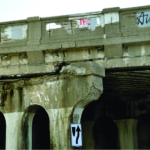Sure, Michigan’s winter potholes wreak havoc on cars in the form of blown tires, bent rims, broken tie rods and destroyed shock absorbers.
But if you have recently engaged in a wintry trek to work and have asked yourself, “Why haven’t they salted this road?” you should know that road crews in Michigan and across the nation apply far more road salt than in the past. According to numerous news reports and scientific studies, the addiction to rock salt during a heavy snowfall over the past several decades presents undeniable drawbacks for motorists and the overall population.
Experts say that de-icing road salt contributes to the premature breakdown of transportation infrastructure, making Michigan’s multi-billion dollar deferred maintenance problems even worse.
Michigan addicted to road salt
In dramatic contrast to the pre-1970s era, drivers in the 21st Century demand clear, clean roads for safe transport. Today, public agencies in Michigan use far more than 1 million tons of rock salt during an especially relentless winter to remove snow and ice. Critics say the salt is distributed unevenly and often in excess.
Yet, salt has plenty of drawbacks. It can corrode the steel in cars, trucks, bridges, and reinforcing rods in concrete — weakening valuable infrastructure. According to Vox.com, transportation departments can add chemicals to road salt to inhibit corrosion or add coating to steel, but this gets pricey. One study in Utah estimated that salt corrosion now costs the US $16 to $19 billion per year.
The Michigan Department of Transportation (MDOT), and its county and state partners, know that about 40 percent of rock salt eventually bounces off the roadways and is rendered ineffective.
Eventually, all of that salt (sodium chloride) washes into Michigan’s lakes and streams, which can make the drinking water in Michigan’s polluted urban areas unsafe. In particular, the state’s worries about lead in drinking water after the Flint water crisis is directly linked to salt content.
Road salt spills into natural waterways and can present hazards for those residents relying on safe drinking water — and not just in Flint — according to one of the heroes who exposed the Flint water debacle, Virginia Tech professor Marc Edwards.
At its worst, Edwards has said, high salt levels — hard to extract and reduce — in a public drinking water source can corrode old water pipes, adding toxic heavy metals such as lead to the water, especially in those rural communities where drinking water is derived from wells that tap into underground aquifers.
In fact, Edwards has told Michigan Radio that unchecked high salt levels in the polluted Flint River likely caused much of the pipe corrosion and lead contamination in Flint’s drinking water system.
Edwards laid out the repercussions for Michigan Radio’s WMUK-FM in Kalamazoo:
The one thing that’s certain is higher chloride is bad. It eats up pipes — the iron pipes, it eats up the lead pipes, it eats up copper pipes. So, this salt is having devastating economic impacts on our infrastructure. And I think if you factor in the billions and billions of dollars that are being lost from corrosion of just the water infrastructure alone, it would make people think twice — if they looked at it carefully — before they put so much salt on the roads.
As for public health, increasing salt levels in drinking water are obviously harmful to those who have to conform to a low-sodium diet. Moreso, the environmental effects can be devastating.
Road salt runoff can create dead zones in lakes. Some streams don’t fare much better. Extra chemicals added to the salt can cause fish die-offs. And the salty soil near roadways can kill trees and other plants.
New approach chews up cars
Several years ago, MDOT moved toward more emphasis on preventative, pre-icing operations before a snowstorm. That involved spraying liquid brine, a watery version of rock salt, often combined with magnesium chloride, on major highways when a major winter storm was predicted. This prevents ice from sticking to the pavement and lessens the need for salting after the fact.
Mark Cornwell, former chair of the Salt Use Quality Improvement Team at the University of Michigan, sees great promise in this winter maintenance approach. The U.S. Environmental Protection Agency believes this can reduce road salt use 41 to 75 percent if it’s done two hours before a storm.
Clearly, salted roads save drivers’ lives.
Yet, there can be a particularly ugly tradeoff in emphasizing the spraying of pre-treatment brine on roads.
In most states, brine is a mix of rock salt, sodium chloride, and magnesium chloride, dissolved in water so they can be sprayed on the road.
Yet, the chemical version of pre-emptive brine used in most of the U.S. eats through your car’s paint and metal – exhaust pipes, mufflers, fenders – or worse, brake lines, gas tanks, steering mechanisms and axles.
So, reforming the salty response by road engineers to Old Man Winter could present this choice: slippery roads, accelerated deterioration of infrastructure, or car repairs that may be worse than anything currently experienced by the lowly motorisst trying to dodge potholes.







This is so interesting. There is an old textile mill in my community that has 3 over passes that need replacing. They are all over a river that was used with the factories. Surprize! Surprize!
Whatever is in that river is still a problem.